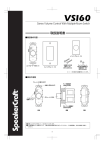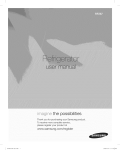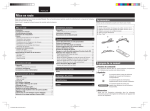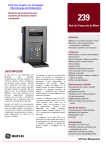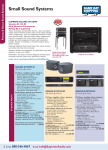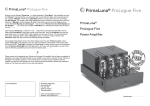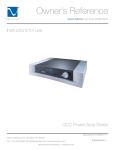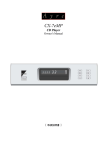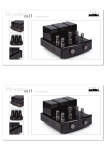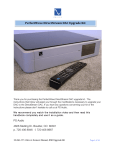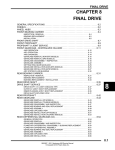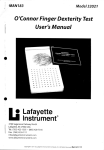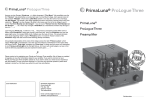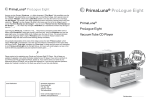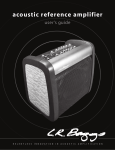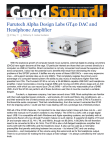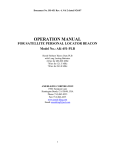Download Review - PrimaLuna
Transcript
EQUIPMENT REPORT ROBERT DEUTSCH PrimaLuna ProLogue Pretniutn INTEGRATED AMPLIFIER 'J Pri malu na* megrared ampli£ers are hot. I don't mean in the literal sense-although having a preampli£er and stereo power arnpli£er in the same chassis usually results in higher running temperatures- but in the metaphorical one. Once \iewed as the rype of component that no serious audiophile woul consider buying, integrated amps have made a come.· in popularity and prestige. Consider: the October 2006 -Recommended Components" issue of Stereophile listed 29 : regrated amps, whereas the October 2011 issue lists 40. · a.'Pizili! s 2010 Ampli£cation Component of the Year award I went to an integrated amp, the Audio Research VSi60, beating out a host of heavy-hitter preamps and power amps. The 2012 Stereophile Buyer's Guide lists 400 integrateds. What accounts for the renewed popularity of this product category? Cost is certainly a facto~ but it's not the only one. You could buy a separate preamp and power amp for the cost of some integrated amps. I suspect that a ~or patt of the appeal is the desire for simplicity: one box instead of two (o~ in the case of monoblock power amps, three) cluttering up the living/listening room, and fewer power cables and interconnects-another cost saving. SPECIFICATIONS :•c< · ;:>'i0n Tubed, remotecontrolled, stereo integrated amplifier. Tube complement: four 12AU7, four EL34 or KT88. Inputs: 4 pairs RCA, 1 pair HT bypass. Outputs: 4 and 8 ohm transformer taps. Maximum output power: 35Wpc with EL34s (15.6dBW), 40Wpc with o:-':-:: - e.::- • June 2012 KT88s (15.9dBW). Frequency response: 20H z-30kHz, ± O.SdB. THD: <1% at full power. Signal/noise: 89dB. Input sensitivity: 300mV. Power Consumption: 300W. Dimensions 14.5" (370mm) W by 8" (205mm) H by 15.5" (400mm) D. Weight: 46.3 lbs (21kg). Serial Number of Un1t Revicwf'd 10044978 (auditioning); 10115729 (measuring). Price $2299. Approximate number of dealers: 35. Manufacturer Durob Audio BV, PO Box 109, 5250 AC Vl ijmen, The Netherl ands. Tel: (31) 73-511-25-55. www.primaluna.nl. US distributor: Prima luna USA, 1042 North Mountain Avenu e, Suite B, PMB 406, Upland, CA 91786. Tel: (909) 931-0219. www.primaluna-u sa.com. 73 \\ben I consider the selection of produas for review, I don't co:m.alh· look for ones that are in the state-of-the-art, cost;:: je~ category, but rather ones that promise to offer high - und quality at a moderate price. Based on my experience c.:;:h the PrirnaLuna ProLogue 1hree pre.amp and ProLogue ~.-en power .amp (see December 2009, Vol.32 No.12), that ?~cry much describes PrirnaLuna's design philosophy. So when : rea PrirnaLuna's announcement of the ProLogue Premium- .e best integrated .amp in its class j ust got better"- ! was keen , check it out. Description and design :r- said that an .amplification component's w eight can tell you ;. .or about its quality. Other things being equal, amplifiers that -,.·eigh more tend to sound better. T wo factors are involved ::ere: transformers and chassis construction. Higher-capacity ;::·eophile .com • June 2012 transformers weigh more and usually result in better sound. H avin g a more solid chassis helps suppress resonances, which negatively affect sound. For a 35Wpc integrated .amplifier, the ProLogue Premium is surprisingly heavy: 46.3 lbs. The chassis has a very solid feel, and the fit'n'finish is of a quality that suggests a much more expensive piece of equipment. The tubes are covered by a cage that can be easily lifted off rather than requiring a tool to remove it. The front panel has two knobs: one for volume, the other for source selection. There is no balance control. Source selection has an unusual logic: no matter what source you've been listening to, when the ProLogue Premium is turned off and then turned on ag.ain, the source defaults to CD. On the left side panel, near the front, there's a rocker switch for power on/off; and on the right side another rocker switch allows selection of bias optimized for EL34 or KT88 power tubes. Accidentally setting this switch to 75 PRIMAlUNA PROLOGUE PREMIUM INTEGRATED AMPLIFIER a tube type not installed does no harm; in fact, the user manual suggests that you experiment with the switch position for personal taste. I explored matching/mismatching the tubes and bias switch positions, and preferred the matched positions. TI1e rear panel sports five pairs of RCA jacks for inputs, one pair labeled HT (for Home Theater). This is not just unity gain, but actually bypasses the preamp section, and allows volume to be controlled by a surround processor/receiver. The ProLogue Premium normally comes with EL34 output tubes, but can also accommodate KT88s, a set of which was included with the review sample. Except as noted, I did my listening with the EL34s. There are connections for speakers with nominal impedances of 4 and 8 ohms. The ProLogue Premium is available with an internal moving-magnet phono stage ($199), but the review sample didn't include this option. The ProLogue Premium was designed in Holland by a team headed by H erman van den Dungen, and, like most audio products these days, it's manufactured in China. According to Kevin Deal of Upscale Audio and PrimaLuna USA, PrimaLuna's North American distributor, the engineering of the Premium began with a circuit design in which nothing was taken for granted, and the components selected are of a quality not normally seen in cost-conscious designs. These include: • Nichicon and Solen polystyrene and tin-foil capacitors • Alps motorized potentiometer (said to be 10 times the cost oflesser parts) • toroidal power transformer, manufactured in-house • capacitor-plus-choke power supply, designed to eliminate both low-frequency ripples and high-frequency hash • custom-designed output transformers, manufactured in-house • heavy-gauge, ventilated chassis with a five-coat flnish • construction by hand and point-to-point wiring The tubes supplied with the ProLogue Premium are SilverLabel, according to Upscale Audio's classilication, and are said to T o take these measurements, I used Stereophile's loan sample of the top-of-the-line Audio Precision SYS2722 system (see t he January 2008 "As We See It," www. stereophile.com/asweseeit/108awsi/ index.html, and www.ap.com). The unit shipped to me for measurement-serial no.10115729, a different sample from the one auditioned by Robert Deutsch-was f itted with EL34 output tubes; I made sure t he bias switch on the amplifier's left side panel was set to the appropriate bias position for that tube. M aximum voltage gain into 8 ohms was on the low side for an integrated amplifier, at 36d B from the 8 ohm output transformer tap and 34dB from the 4 ohm tap, but this shouldn't be an issue with modern line-level source components. The ProLogue Premium preserved absolute polarity and the input impedance was 35k ohms across the audioband, dropping to 30k ohms at 20kHz. Though these figures are around half the specified 68k ohms, they s:e·eophile.com • June 2012 be already "special" compared to standard tubes on the market. Other tubes, including cryogenically treated ones, are available from Upscale. The ProLogue Premium has a number of specific, trademarked circuits designed to optimize performance and prevent damage to the amplifier in the event of a malfunction: • Adaptive AutoBias (AAB) monitors and adjusts bias constantly. AAB was present in previous PrimaLuna amplifiers, but the latest version is said to include more extended outputstage protection circuitry, to safeguard the output transformers, resistors, and high-voltage power supply in case a tube fails. • Bad Tube Indicator (BTl) is what PrimaLuna calls the red LED next to each output tube, though BTl is not quite what its name implies. A lit BTl LED indicates that the tube is drawing m ore power than it should; however, this condition may be only temporary, and not necessarily indicate a bad tube. If the BTl comes on, you're advised to turn off the ProLogue Premium, wait a few minutes, and turn it on again. If no BTl LEDs light up, you're fine. It's only when the indicator stays on that the cause is likely a bad tube, which must then be replaced. During the review period, there were a few instances of a BTl coming on, but each time, turning the amplifier off and then on again fixed the problem. • Power Transformer Protection (PTP) is a thermal switch built into the AC transformer. If the internal temperature gets too high, the AC is switched off autom atically, coming back on again when the problem is resolved. This never happened during the review period. • Output Transformer Protection (OTP) protects the output transformers from high-voltage transients. Power in my system is supplied by a PS Audio PerfectWave Power Plant 5, which is designed to protect against transients of this sort; in any case, there were no problems in this area. • SoftStart is yet another protection circuit, designed to will result in no practical consequences. I assess an amplifier's output impedance by comparing the output voltages when it is loaded down with 8 and 4 ohms with the voltage when it is loaded only by the Audio Precision's 100k ohms. Things went smoothly with the 4 ohm tap, which measured 1.7 ohms across the audioband. However, when I tried to measure the impedance of the 8 ohm tap, the :~~ . ·• - ~n 10 20 50 100200 500 11<. 21<. 5k 101<.201<. 50k. 2001<. "' Fig.l Prima luna Prologue Premium, 8 ohm tap, frequency res ponse at 2.83V into: simulated loudspeaker load (gray), 8 ohms (left channel blue, right red), 4 ohms (left cyan, right magenta), 2 ohms (green) (1dB/vertical div.). amplifier went into runaway ultrasonic oscillation when not loaded down, causing the Prologue to mute its output and illuminate one or more of the Bad Tube Indicator (BTl) LEOs. Normal service was restored when I left the amplifier turned off for a few minutes, then turned it back on, but Prologue Premium owners must take care never to disconnect their speakers when the amplifier is powered up. -10 10 20 50 100200 500 1k 2k ' ~ Sk 101<.201<. 50k 2001<. "' Fig.2 Prima luna Prologue Premium, 4 ohm tap, frequency response at 2.83V into: simulated loudspeaker load (gray), 8 ohms (left channel blue, right red), 4 ohms (left cyan, right magenta), 2 ohms (green) (ldB/vertical div.). 77 ~ !. PRIMALUNA PROLOGUE PREMIUM INTEGRATED AMPLIFIER The tube cover has glass side panels. extend the life of sensitive components and reduce the chance of tube failure from thermal shock. The basic design of the ProLogue Premium follows triedand-true principles: the output stage runs in Ultralinear mode, and tubes run well below their maximum ratings. Like other products in PrimaLuna's Premium range, the ProLogue uses double 12AU7s in each channel rather than the earlier combination of 12AX7 and 12AU7. This is said to result in much lower distortion in the first stage. The ProLogue Premium includes a solidly built remote control that also controls the basic functions ofPrimaLuna CD players. I found the remote to work extremely well to set the desired volume: a very brief depression of the Up or Down button resulted in a correspondingly minimal change in volume, with no overshoot. Like most remotes, this one has buttons of identical shape and size. Since there are only six buttons, remembering the most frequently used ones, Up/ Down/Mute, is not that difficult, but I wish they'd made the Up and Down buttons differently shaped or sized from the others, so that they could be identi£ed by touch. The impedance of the 8 ohm tap appeared to be around 2 ohms, which gave rise to audible ±1.8dB variations in the amplifier's response when connected to our standard simulated loudspeaker (fig.1, gray t race). There were some slight variations in response even into purely resistive loads, but more important, at the 200kHz upper limit of this graph can be seen a large resonant peak whose height Setup Setting up an integrated amp like the ProLogue Premium should be pretty straightforward: connect the source interconnects, speaker cables, and, last, the power cord; make sure the volume control is turned all the way down; turn it on. Sounds simple enough, but I ran into a problem at the very first stage: plugging in the interconnects from the CD player. The ProLogue Premium's RCA jacks have plastic covers on them, and I had a difficult time trying to remove the ones over the CD input pair. (The user's manual makes no reference to these protective covers; they may have been a late addition.) Pulling on them didn't seem to work, so I started twisting one of them-and then I felt it give, and the entire input jack started turning! Not good-I'd inadvertently broken the internal connection to the CD input jacks. To repair the damage, with Kevin Deal's approval, I engaged the services of a highly experienced audio technician, Roger Sherman, who carne to my home and was able to resolder the connection without difficulty. I eventually found out that there's a trick to removing the protective caps. There's a part that provides for a grip (it was facing the bottom, so I didn't see it); once you take hold of that, you can easily pull the cover off. This problem solved-and both channels of the CD input working properly-I was ready to do some listening. According to the folks who view measured electrical performance as the only criterion for the assessment of an amplifier, once an amplifier's internal components have reached operating temperature, the amplifier is performing as well as it's ever going to perform: "break-in" and "warm-up" (beyond a minute or so) are simply myths. But most audiophiles and manufacturers of audiophile equipment know that break-in and warm-up phenomena are real, and that amplifiers vary in these characteristics. In discussing the effect of replacing tubes, PrimaLuna notes that "break-in yields improvements." In the case of the ProLogue Premium, I found that over a period of several weeks, with the amplifier ori 9-10 and frequency increased with increasing load impedance. With the lOOk ohm input impedance of the Audio Precision test system, the amplifier became unstable and went into oscillation at the frequency of this peak. Th.is ultrasonic peak was better-damped from the 4 ohm tap (fig.2), when the variations in response with our simulated loudspeaker were a less-audible ±1dB (gray trace). But the ultrasonic resonance resulted in and ringing with the Prima luna driving a 10kHz squarewave into 8 ohms from the 8 ohm tap (fig.3). Even from the 4 ohm tap, some overshoot can be seen with a 1kHz squarewave (fig.4), though the flat tops of this waveform are a testament to the ProLogue Premium's extended low frequencies. These four graphs were taken with the volume control set to its maximum. +DE 2 [ -20 b I ~ > e~--~----1-~--+-~--+-1 r= - ~ -<of-F----+----+----------+--- ~ ' 0 " 1-·2 00 r---1 - I I 1.0 1.5 20 200 "' Fig.3 Prima l una Prologue Premium, 8 ohm tap, small-signal 10kHz squarewave .into 8 ohms. stereoph ile.com • June 2012 Fig.4 Prima luna Prologue Premium, 4 ohm tap, small-signallkHz squarewave into 8 ohms. Fig.S Primaluna Prologue Premium, 8 ohm tap, spectrum of noise floor ref. 1W into 8 ohms, DC-1kHz (left channe.l blue, right red; linear frequency scale). 79 PRIMALUNA PROLOGUE PREMIUM INTEGRATED AMP LIF IER hours a day and playing music 3-4 hours a day (I leave the CD player on all the rime), there was an improvem ent: the music sounded more detailed, and somehow more "relaxed" and freeflowing. It also seem ed to m e that, playing music each day for several hours, there was a similar sonic improvement, suggesting a warm-up effect beyond the few minutes it takes the tubes to reach their normal operating temperature. I noted these effects while using the Avantgarde Uno Nano speakers; the warm-up effect was also apparent with the GoldenEar Triton Twos. I decided to evaluate it in a more systematic way. First, with the GoldenEar Triton Twos in the system , I turned on the ProLogue Premium, waited five minutes, and played track 3 of the C hesky Records Jazz Sampler & Audiophile Test OJmpad Disc, vol.t (C hesky JD37). I listened carefully, noting all the little sonic details, stopped the CD, and lefi: the room for an hour. I then went back to the listening room- where the system had been on all this rime, but without playing music-and listened to the same track again. (The volume control was not touched.) My conclusion- which those who want double-blind controls are free co ignore-was that there was indeed an improvement, and of the son that I'd previously noted more informally. What I thought \Yas interesting was that the improvement did not depend on the speakers playing during the warm-up period. It's possible that playing the speakers would result in a further improvement in the sound, but it would require some additional comparisons to determine if this is the case. Sound: Take One I used the ProLogue Premium with three speakers: my reference Avantgarde Acoustic Uno Nanos (reviewed in July 2009), the GoldenEar Triton Twos (February 2012), and, briefly, the M arti.nLogan Monti.ses (soon to be reviewed) . These speakers represent a wide range of design approaches, and sound quite different from each other. First up were the Avantgardes. With these speakers, I always experience a degree of trepidation when I turn on the system afi:er installing a new amplifier. Never mind an y subtleties of sound quality- is there noise (hum or buzz) at a level that's likely to interfere with my e1~oyment of the music? Whatever noise there is at the output of the amplifier, the Avantgardes, with their +1OOdB sensitivity, will let m e hear it. I can try to "listen past the noise," but I don't like having to do so. With the last amplifier I reviewed, the otherwise admirable Conrad-Johnson LP125M (December 2011), I had to go to all kinds of trouble-grounding/ ungrounding different parts of the system and dressing the interconnects-before the noise abated to the point where it was negligible. Turning on the system with the ProLogue-Avantgarde combination for the first rime, I was much relieved to find it dead quiet. With the volume turned way up but no music playing, no sound carne from the speakers; it was as if the system were not on at all. Very impressive-and it boded well for the rime I w as about to spend with the ProLogue. The Avantgardes are known to present a high-impedance load, so I connected them to the Premium's 8 ohm tap s; a brief comparison using the 4 ohm taps showed only a marginal difference, one in favor of the 8 ohm connection. The preamp and power amp that I've found to work most optimally with the Ava.ntgarde Uno Nanos are Convergent Audio Technology's SL-1 Renaissance and Audiopax's Model88 Most audiophiles and manufacturers of audiophile equipment know that break-in and warm-up phenomena are real, and that amplifiers vary in these characteristics. measurements, continued Commendably, here was no change in the response · the volume control set to ter positions and the channel balance excellent el separation (not shown) , a > 70d B in both direction z, but just SO dB at 20kHz. I --'E£ a 1 possibl e ways of connecting ·-e gro nd of the Prima luna ampli· "e :o hat of the Audio Precision test , includi ng running a separate . -•e om the Prologue Premium's grounding post on its rear terminal to the AP's chassis, but whatever I tried, the wideband, unweighted signal/noise ratio, taken with the input shorted and the volume control at its maximum and ref. lW into 8 ohms from the 8 ohm tap, was a disappointing 57.3dB in the left channel, 63.1dB in the right. As shown by fig.S, this was because some low-level hum was present at the AC supply frequency and its harmonics. Switching an A-weighting filter into circuit improved the measured ratios to 76.8 and 77.7dB, left/right, respectively, which gives a closer estima· tion of the audibility of this noise. Even so, I note that RD had no noise problems w ith his sensitive Avantgarde horn speakers, so perhaps his sample of the Prologue Premium was quieter than mine. What I did find with my sample was that it was mildly microphonic. If I banged the top of the transformer cover-even with the input shorted-I could generate a ringing tone with a frequency of around 250Hz 10 10 % % ~=--~ 500m 1 2 5 10 20 501 00 w ----------------------------~ ~""-..tuna ;s ·<Hz Prologue Premium, 8 ohm tap, distorconti nuous output power into 8 ohms. 0 .5 0.5 0.2 02 - 0 1 01 100m200m 500m 5 1 10 20 50 100 w Fig.7 Primaluna Prologue Premium, 4 ohm tap, distorlion(%) vs 1kHz continuous output power into 8 ohms. 100m200m ~- SOOm 5 1 10 20 50 100 w Fig.S Primaluna Prologue Premium, 4 ohm tap, distorlion (%) vs 1kHz continuous output power into 4 ohms. ' . ;,:: · = :o n • Jun e 2012 81 ..:; ·· PRIMALUN A PROLOGUE PREMIUM INTEGRATED AMPLI FIER Mk.II. The 30Wpc of the Audiopax is more than enough to run the Avantgardes to high levels, and the combination provides a near-ideal mix of timbral accuracy, detail, and dynamics. Changing from the CAT-Audiopax to the ProLogue Premium might be expected to have produced a sense of disappointment, but my feeling was one of excitement: this integrated amp, costing a mere fraction of the CAT-Audiopax combo ($32,000 with the latter in its current, Mk.III form), was able to produce sound that was faithful Turning on to the source, musically involving, and the system altogether very listenable. Like other tube preampli£ers and ampli£ers that with the I have experience with, the ProLogue ProLoguePremium had a special way with Avantgarde voices, reproducing them in a way that combination had a more "human" quality than with even topnotch solid-state products like for the the Simaudio Moon Evolution W-7 power ampli£er. first time, more ctitically, comparI was much ingListening the ProLogue Premium with the relieved CAT-Audiopax at matched levels, I heard some differences. With the CATto find it the sound was more condead quiet. Audiopax, vincingly three-dimensional, with more "air" around voices and instruments; the highs were more detailed without becoming overly bright; and it was easier to follow the music's subtle ebb and flow. These differences-apparent when I was wearing my "sharpener'' hat-are to be expected, given the price difference. People who have $18,000 to spend on speakers like the Avantgarde Uno Nanos can usually afford to spend more than $2299 on an integrated amp, and probably should, to get the most from their speakers. Howeve~; if you've picked up a used pair ofUno Nanos (or Unos or Duos) and a level of 30mV RMS. I doubt that this will be a problem in normal use. With the amplifier's output transformer tap matched to the load, the Prima luna Prologue Premium just met its specified power of 35Wpc (15.6dBW). Fig.6 shows how the THD+noise percentage present in the 8 ohm output changes with power into 8 ohms. The THD+N reaches 1%, our standard definition of clipping, at 35Wpc. Figs. 7 and 8 show ·o - ·~ T :~r 50 100 200 500 1k Sound: In the Real World The Avantgarde Uno Nano is a rare bird: ultra-high efficiency, horn-loaded midrange and tweeter, powered subwoofer. Evaluating an amplifier with this speaker, while useful, doesn't tell you how the amp will fare with more conventional speakers-and, of course, there's a major mismatch in price. Keeping these factors in mind, I spent most of my ProLogue Premium reviewing time using speakers that are less exotic in design and provide a better price match: the GoldenEar Triton Twos. The Triton Two is one of my favorite speakers: a floorstanding three-way that sells for $2999/paii; whose sound quality comfortably exceeds what is normally expected at this price level. Like the Uno Nano, the Triton Two incorporates a powered subwoofer. Its claimed sensitivity, confmned by John Atkinson's measurements, is 91dB--somewhat higher than the norm, but much lower than the Uno Nano's. JA also noted that "the speaker will not be too difficult for the partnering ampli£er to drive." The combination of the Triton Twos and the ProLogue Premium proved particularly synergistic- it was as if each designer had used the other's speaker to fine-tune the sound of his own. The speakers sounded good through the ProLogue Premium's 8 ohm connectors, and even better-more dynamic, more "present''-through the 4 ohm taps. Comparing the ProLogue Premium to the Audiopax 88 Mk.II and the Simaudio W-7, each driven by the CAT SL-1 Renaissance preamp, there were areas of performance in which each of these high-end references sounded superior. The Audiopax's m;yor area of superiority was its ability to present recordings that normally sound a bit harsh in a way how the THD+N percentage changes with the 4 ohm tap driving 8 and 4 ohms, respectively. The Prologue Premium clips at 21Wpc into 8 ohms (13.2dBW) and 32W into 4 ohms (12dBW), but the amplifier does meet its specified power from this tap at 1.4% THO. I haven't shown the clipping behavior into 2 ohms from either tap, as the amplifier switched itself off and lit one or more BTl LEOs as the power reached 40Wpc into this load. As figs. 6-8 make clear, the Prologue Premium is not a low-distortion design. I plotted how its THD+N percentage changes with frequency at 4.8V, a level equivalent to 2.9W into 8 ohms, where I could be sure that the distortion was higher than the noise floor. The results are shown in figs. 9 (8 ohm tap) and 10 (4 ohm tap). The amplifier is more linear from its 4 ohm tap, but there are significant rises in distortion at the frequency + ~ :: ~FWf+ i7 .. ,20 at a bargain price and don't have a lot of money left ove~; the ProLogue Premium would give you maybe 900fo of what these speakers are capable of-and outside of an AlB comparison, you wouldn't know what you were missing. 2k. Sk % 10k20k Tim e in ms "' Fig.9 Prima luna Prologue Premium, 8 ohm tap, Fig.lO Prima luna Prologue Premium, 4 ohm tap, THD+N (%) vs frequency at 4 .8V into: 8 ohms (left THD+N (%) vs frequency at 4.8V into: 8 ohms (left channel blue, right red), 4 ohms (left cyan, right magenta ), 2 ohms (gray). channel blue, right red ), 4 ohms (left cyan, right magenta), 2 ohms (gray). ;:ereophile.com • June 2012 Fig.ll Prima luna Prologue Premium, 4 ohm tap, 1kHz waveform at lW into 4 ohms (top), 0 .1 04% THD+N; distortion and noise waveform with fundamental notched out (bottom, not to scale). 83 PRIMALUNA PROLOGUE PREMIUM INTEGRATED AMPLIFIER that made me think that the recording sounded better than I'd realized. Come Fly With Me (CD, Capitol CDP 7 48469 2) catches Frank Sinatra at his confident best, with Billy May's arrangements and musical direction providing perfect support, but there's no getting around the fact that the massed strings have a certain edge, whether from limitations of the 1957 recording technology or the digital transfer. Tbis edge was less noticeable through the CAT-Audiopax combo than through the ProLogue Premium. The Moon W-7 had more of this edge than the ProLogue Premium-and much more than the Audiopax-but it beat both tubed amps in its sense of power and dynamics, had more extended bass, and was able to drive the speakers to a higher level without strain. The sonic character of the ProLogue Premium was in between the Audiopax and the Moon W-7. At times, listening to the system with the Audiopax in it, I thought, Yes, this is the way it's supposed to sound-and then I began to get the feeling that the sound was too smooth, too liquid. into impedances. This amplifier really does need to be used with speakers with the same nominal imp.edance as the transformer tap or higher. Fortunately, at low powers into high impedances, the distortion is strongly second-harmonic in nature (fig.ll), which is relatively innocuous. At higher output currents, the third starts to develop (fig.12), and even at moderate powers at low frequencies, a regular Similarly, when listening to the system through the Moon W-7, I was impressed with the clarity, definition, and dynamic swing-Yes, this is more like the real thing. Then my critical self again reared its head, and I began to feel that the sound was a bit on the aggressive side, pushing the music toward me rather than drawing me into it. And whenever I switched over to the ProLogue Premium, I had the feeling that here was an amplifier-speaker combination that just "clicked." For an integrated amplifier that costs a mere fraction of these high-end references, this is remarkable performance. The ProLogue Premium's Home Theater input bypasses the preamp section, including the volume control. I did a trial using this input, connecting it to the output of the CAT preamp, with the Ayre Acoustics CX-7eMP CD player connected to the CAT preamp's input. In this setup-in which I used the ProLogue Premium as only a power arnp- I could evaluate the contribution of the ProLogue's preamp section to the sound. When I compared the ProLogue Premium with the CDplayer interconnects plugged directly into its CD inputs vs into one of the CATs line-level inputs, the output of the CAT driving the ProLogue's amp section directly, the differences were not great but were significant. The tonal balance remained much the same, but with the CAT doing the preamplification there was a definite improvement in what I might call finesse-the percussion instruments in track 3 of the Chesky test CD were clearer and more distinct, but also more delicate, and with no added edge or harshness. Double-bass notes were also more clearly defined. Bass drums had greater weight. Given that the CAT SL-1 Renaissance is widely recognized as one of the world's best preamps, and costs nearly four times as much as the ProLogue, the fact that it sounded better than the Premium's preamp section shouldn't come as a surprise. The real surprise is how close the ProLogue's preamp section carne to the sound of the reference-quality CAT SL-1. picket fence of higher-order harmonics appears (fig.13); At the other eQd of the spectrum, despite theamplifier's decreasing linearity at high frequencies, the Prima luna did quite well on the high;:frequency intermodulation test. At a level about 3dB below visible waveform clipping on an oscilloscope, ·the second-order difference product at 1kHz resulting from an equal mix of 19 and 20kHz tones was at -56dB (0.15%), with the n11zner·-or·aer 21kHz lying at -60dB (0.1%) (fig.14). Primaluna's Prologue Premium measures about as well as I expect from a classic tube design that uses a push-pull pair of El34 output tubes. Both the hum and the amplifier's instability when unloaded probably stem from the compromises necessary to manufacture a transformercoupled amplifier of this sort that sells for a relativelyaffordable price.-JohnAtlcinson -20 -40 -60 -80 -100 10k 15k "' Fig.12 Primaluna Prologue Premium, 8 ohm tap, 1kHz waveform at 2W into 4 ohms (top), 0.584% THD+N; distortion and noise waveform with fundamental notched out (bottom, not to scale). stereophile.com • June 2012 -~ ,. '! Fig.13 Primaluna Prologue Premium, 4 ohm tap, spectrum of 50Hz sinewave, DC-1kHz, at 10W into 8 o~ms (left channel blue, right red; linear frequency scale). Fig.14 Primal una Prologue Premium, 4 ohm tap, HF intermodulation spectrum, DC-24kHz, 19+20kHz at 13W peak into 8 ohms (left channel blue, right red; linear frequency scale), 85 PRIMALUNA PROLOGUE PREMIUM INTEGRATED AMPLIFIER connectors, the combination of ProLogue Premium and MartinLogan Montis became a more-than-credible match, despite the m~or disparity in their prices. Conclusions and System Building The EL34 output tubes can be replaced with KT88s. Sound: More Exotica As I neared the end of my time with the ProLogue Premium, a pair of MartinLogan Montis speakers arrived for review. The Montis ($10,000/pair) features an electrostatic midrange/ tweeter mated to a powered woofer. Electrostatics are notorious for presenting a difficult load to amplifiers (the specifications for the Montis state that its impedance at 20kHz drops to 0.52 ohm), but having a woofer with its own amplifier should help. Since the ProLogue Premium was the first amplifier I used with the Montis, I had no background to draw on to determine if, in fact, the ProLogue was a good match for this speaker, but it sounded pretty good to me. Mark Aling of Paradigm! MartinLogan, who helped me set up the Mantises, and who has heard them in other contexts, indicated that he was pleased with the sound. Whatever the effect of the low-impedance load in the high treble, the ProLogue Premium didn't seem fazed by it- perhaps because there's so little musical content up there. A test with the CAT-Audiopax quickly revealed that this was not a good combination: the treble was much softer than ideal, and the amp ran out of steam at higher-but not roomshaking- levels. The ProLogue Premium fared better; the highs were still a bit subdued, but to a lesser extent. As mentioned earlier in the review, my listening throughout was with the EL34 output tubes. When I had the GoldenEar Triton Twos in the system, I did a brief trial using the KT88s, and I much preferred the EL34s' more laid-back sound. The ProLogue Premium's rated output using the EL34s is 35Wpc, whereas with the KT88s it's 40Wpc-a difference small enough that I thought it would be inconsequential. Nevertheless, I swapped out the EL34s for KT88s (remembering to change the position of the bias switch), and, whether because of the minor power difference or other reasons, I preferred the sound with the KT88s. Unlike with the Triton Two, where the sound with the KT88s was a bit on the brash side, with the Montis the sound was tonally better balanced than with the EL34s, with more extended highs and a more dynamically lively presentation. My last comparison involving the Montis and the KT88equipped ProLogue Premium involved changing from the 4 ohm to the 8 ohm speaker connectors. The Montis is rated at 4 ohms, but is described as being "compatible with 4, 6, or 8 ohm rated amplifiers." I fully expected that the 4 ohm output would produce better results, as it had with the Triton Two. Not so! The sound using the 8 ohm connectors was more open and better focused. It just goes to show you that in audio there's little that you can take for granted. With the KT88s and the 8 ohm speaker stereophile.com • June 2012 Built to a high standard, the PrimaLuna ProLogue Premium offers outstanding sound quality at a very reasonable price. In my listening tests, it combined well with speakers both conventional and exotic, and gave high-end references more than a run for their money. Audiophiles often complain about how expensive this hobby has become-and not without justification. In apportioning the job of reporting on amplification components at the 2012 Consumer Electronics Show, Larry Greenhill and Stephen Mejias set $5000 as the dividing line between "inexpensive" and "expensive." (Stephen tells me that he would have liked to set the cutoff at $1000, but there simply wasn't enough at CES below that price, which would have led to an unequal division oflabor.J The 2012 Stereophile Buyer's Guide lists 29 integrated amps costing $10,000 or more, including one that comes in at a cool $100,000. Is this sheer madness? What tends to be forgotten during the expressions of outrage about high prices is that if you ignore equipment at "crazy prices"-and, of course, each of us has his or her own idea of exactly where "craziness" begins-ours is a great age for the costconscious audiophile. If you do your homework on what's available, read The the reviews, and visit dealers who PrimaLuna make a point of offering their customers value, you can assemble a system ProLogue for a reasonable price that- with attenPremium tion paid to component matching and offers setup-can offer sound quality that comes close to the cost-no-object. outstanding The ProLogue Premium would be sound quality an excellent component around which to start assembling such a system. I at avery found it combined well with speakers reasonable as disparate as the Avantgarde Uno price. Nano, GoldenEar Triton Two, and MartinLogan Montis. The ProLogue Premium also allows some fine-tuning to match the speakers: there's a choice of output tenninals (8 or 4 ohms), switchable power-tube bias, and a choice of power tubes (EL34 or KT88). Playing the system-building game, first with an emphasis on keeping the total system price down, I would combine the ProLogue Premium ($2299) with the Marantz CD5004 CD player ($350), and with something like the Dynaudio Excite X12 ($1200/pair) or PSB Imagine B ($1100/pair) speakers, plus some entry-level cables from AudioQuest or Kimber Kable. At a total price of around $4000-plus another $400 for a Pro-Ject Debut III turntable and $199 for the PrimaLuna phono stage to get you into the world of vinyl- you'd have a musically satisfying system that represents outstanding value. At the next system price level, the obvious partnering loudspeaker for the ProLogue Premium is the GoldenEar Triton Two. Keeping everything else the same, you'd have a system price of about $6000. Further improvements could come from upgrading the digital source (I'd first check out Oppo's BDP-95 SACD/CD player, for $1000)-and consider getting better cables and a power-line conditioner. For a total price well under $8000, this system could easily compete with the typical rig costing $20,000. Yes, this is a great time to be an audiophile. • 87









